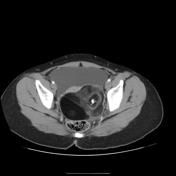Items tagged “pm”
206 results found
Article
Os vesalianum pedis
An os vesalianum pedis is an accessory ossicle of the foot. Although asymptomatic, it may become symptomatic occasionally, causing lateral foot pain and requiring surgical excision 2.
Gross anatomy
It is formed as a result of failed fusion of the secondary ossification center of the metatarsal...
Article
Zuckerkandl tubercle
Zuckerkandl tubercles are the projections of normal thyroid tissue from the posterior or posteromedial margin of the thyroid gland that extend posterior to the tracheoesophageal groove. They are present in most patients and occur more commonly on the right and in the longitudinal center 50% of t...
Article
Acrodysostosis
Acrodysostosis is a rare skeletal dysplasia characterized by growth retardation, nasal hypoplasia, brachydactyly, midfacial deficiency, intellectual disability and deafness.
Pathology
Most cases are sporadic. Few cases with autosomal dominant transmission have been reported. It is believed to ...
Article
Bloom syndrome
Bloom syndrome is a rare autosomal recessive disorder characterized by short stature, brachydactyly, malar hypoplasia and facial telangiectasia, erythema and cafe au lait spots. Affected individuals have an increased risk of developing malignancies.
Pathology
There is extreme chromosomal fragi...
Article
Brachydactyly type A2 (Mohr-Wriedt type)
Brachydactyly type A2 or Mohr-Wriedt type is characterized by hypoplasia/aplasia of the second middle phalanx of the index finger, second toe and sometimes little finger. There is radial deviation of the index finger and tibial deviation of the second toe.
Pathology
Type A2 brachydactyly can b...
Article
Brachydactyly type A3
Brachydactyly type A3 is characterized by shortening of the middle phalanx of the little finger with radial deviation of distal phalanx. Slanting of the distal articular surface of the middle phalanx leads to radial deflection of the distal phalanx. However, it is not always associated with clin...
Article
Brachydactyly type A4 (Temtamy type)
Brachydactyly type A4 or Temtamy type is characterized by brachymesophalangy (absent or hypoplastic middle phalanx) of the second and fifth fingers. Other less common features include club foot, clinodactyly, ulnar deviation of the second finger.
Pathology
Like other brachydactyly, type A4 is ...
Article
Brachydactyly type A5
Brachydactyly type A5 is characterized by absence of the middle phalanges and nail dysplasia with duplicated terminal phalanx of the thumb with resultant bifid thumb. Inheritance is suggested as autosomal dominant.
Case
Mature cystic teratoma

Published
05 Mar 2014
68% complete
CT
Case
Ileocecal tuberculosis

Published
05 Mar 2014
95% complete
CT
Article
Whipple disease (neurological manifestations)
Neurological manifestations of Whipple disease are rare. Whipple disease may appear as a primary neurological disorder in rare cases. It is rarely found as a cause of progressive neurological deterioration in patients.
It has been suggested that neurological involvement will eventually occur in...
Article
Whipple disease (thoracic manifestations)
Thoraco-pulmonary manifestations of Whipple disease are uncommon and present in the late stages of the disease.
Epidemiology
Lung involvement is seen in 35-60% of patients with gastrointestinal whipple disease.
Clinical presentation
Majority of patients present with non-specific pulmonary an...
Article
Cerebral arteriovenous fistula
Cerebral arteriovenous fistulae (CAVF) are cerebral vascular malformations or acquired conditions in which there is an abnormal direct communication between a venous and an arterial channel without the presence of a true nidus.
dural arteriovenous fistula (DAVF)
caroticocavernous fistula (CCF...
Article
Dural arteriovenous shunts
Dural arteriovenous shunts (DAVS) are rare congenital arteriovenous malformations (CAVMs). On the basis of clinical and anatomical features DAVS have three different types:
dural sinus malformations (DSMs)
infantile or juvenile DAVS (IDAVS)
adult DAVS (ADAVS)
Article
Dural sinus malformations
Dural sinus malformations (DSMs) are congenital vascular malformations characterized by massive dilatation of one or more dural venous sinuses. This condition is typically associated with arteriovenous shunts (DAVS).
Subtypes
There are two types of dural sinus malformations (DSM):
DSMs involv...
Article
Cantlie line
Cantlie line is a vertical plane that divides the liver into left and right lobes creating the principal plane used for hepatectomy. It extends from the inferior vena cava posteriorly to the middle of the gallbladder fossa anteriorly.
It contains the middle hepatic vein, which divides the liver...
Article
Cerebral veins
The cerebral veins drain the brain parenchyma and are located in the subarachnoid space. They pierce the meninges and drain further into the cranial venous sinuses.
The cerebral veins lack muscular tissue and valves. The cerebral venous system can be divided into:
superficial (cortical) cerebr...
Article
Septal cerebral veins
Septal cerebral veins originate at the lateral aspect of the anterior horns of the lateral ventricles then pass medially, inferior to the genu of the corpus callosum. They then turn backwards and traverse along the septum pellucidum and enter the internal cerebral vein behind the foramen of Monr...
Article
Thalamostriate veins
Thalamostriate veins are formed by the joining of anterior caudate vein and the vein of stria terminalis. They join the septal veins and form internal cerebral veins.
Related pathology
The thalamostriate veins can be compressed in preterm neonates who have had germinal matrix hemorrhage. This ...
Article
Callosomarginal artery
The callosomarginal artery, also known as median artery of corpus callosum, is the largest branch of the pericallosal artery. It courses within or posterior to the cingulate sulcus, in parallel orientation to the pericallosal artery. It divides to give two or more cortical branches to supply the...







 Unable to process the form. Check for errors and try again.
Unable to process the form. Check for errors and try again.